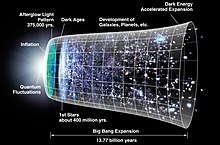A Comprehensive Guide to World History/Prologue
The Prologue to History
[edit | edit source]
There was no time. There was no space. There was simply nothing. The universe was but a state of immense heat and energy, and incredible density. Such a scale of energy and heat that was so compact was the precursor to all history, and by means still not exactly known, the dense state of heat and energy suddenly and rapidly expanded, travailing at a speed barely comprehensible. The Big Bang. Just a mere second after the universe came into existence it was at a temperature of 5.5 billion Celsius (10 billion Fahrenheit). This cosmic plasma soup contained a vast array of fundamental particles such as neutrons, electrons, and protons, which as the universe gradually cooled died off. 13.798 ± 0.037 billion BCE. The start of history. Over the next billions of years the universe continued to cool off and expand, even to this day, it is still expanding from the force of the Big Bang. Eventually, hydrogen, helium, and lithium, created from particles formed by the Big Bang, started to come together to form heavier elements, which would in turn form stars.
Why does this matter? Why is Astronomy history being discussed in a world history wikibook? Because humanity itself is made from the big bang. Carbon-based lifeforms are made up of elements first conceived in the Big Bang. The particles of the early universe are what form our bodies. We are made of star stuff. Further more, the advancement of humanity is also possible only through the formation of the universe. The natural metal and ore deposits on Earth shaped history, as everything from weapons and armor to plows and eating utensils would not be possible if the right elements had not formed in the Big Bang. While obviously in the broad sense the Big Bang created history by creating time itself, the Big Bang contributed all of the necessary conditions and elements for human civilization to arise. People in the past were often fascinated by space and the stars, and rightfully so. Everything we know today came from the stars. Even you, the reader, has portions of the universe from the Big Bang flowing through your veins, beating in your chest. In order to understand and appreciate the proceeding guide through history, it is important to know that all of it was due to a cosmic coincidence that remnants of still can be seen today. Perhaps the amazement with the cosmos is symbiotic, as we continue to study the force that brought us into creation, that force also ever studies us, watching us grow and evolve as our society and civilizations advance. And in that cosmic sense, that is the essence of history.